Located in Ile de la Cité, the Notre Dame Cathedral is Paris’ beating heart. The center of religious power in Medieval times, Notre Dame is one of the first cathedrals in the world built in the Gothic style.
Visiting Notre Dame Cathedral is a must on every trip to Paris. Following five years of reconstruction work, it is possible to visit Notre Dame again, which I recommend! While waiting for your visit, here are some interesting facts about Notre Dame Cathedral.
Are You Planning a Trip to Paris Last Minute?
If you are booking a last-minute trip to Paris, I’ve got you covered! Below are our guides, top tours, hotels, and more:
» Plan: Paris Travel Planner; Paris Arrondissements Guide; Check out the best Paris Metro tickets for tourists
» Book your flight tickets with Omio; book your train tickets with Omio
Book your transfer from the airport to the city with Welcome Pickups.
» Where to Stay: Best Districts to Stay in Paris
- Le Pavillon de la Reine (historical 5-star hotel in Le Marais)
- Hotel La Comtesse (mid-range hotel with Eiffel Tower view from all the rooms!)
- Hotel Ducs de Bourgogne (super central 4-star hotel near the Louvre)
» Top-Rated Paris Tours & Tickets:
- Louvre Museum Skip-the-Line Ticket
- Eiffel Tower Summit Access Ticket
- Seine River Night Cruise
- Château de Versailles and Gardens
- Catacombs Skip-the-line tour with VIP access to restricted areas
Want skip-the-line access at museums & attractions in Paris? Get your hands on a Paris Museum Pass!
» Don’t leave without travel insurance! SafetyWing Essential plan works well for long and short trips (from 5 days up). Can also cover electronics theft through their add-on.
Table of Contents:
History of Notre Dame Cathedral
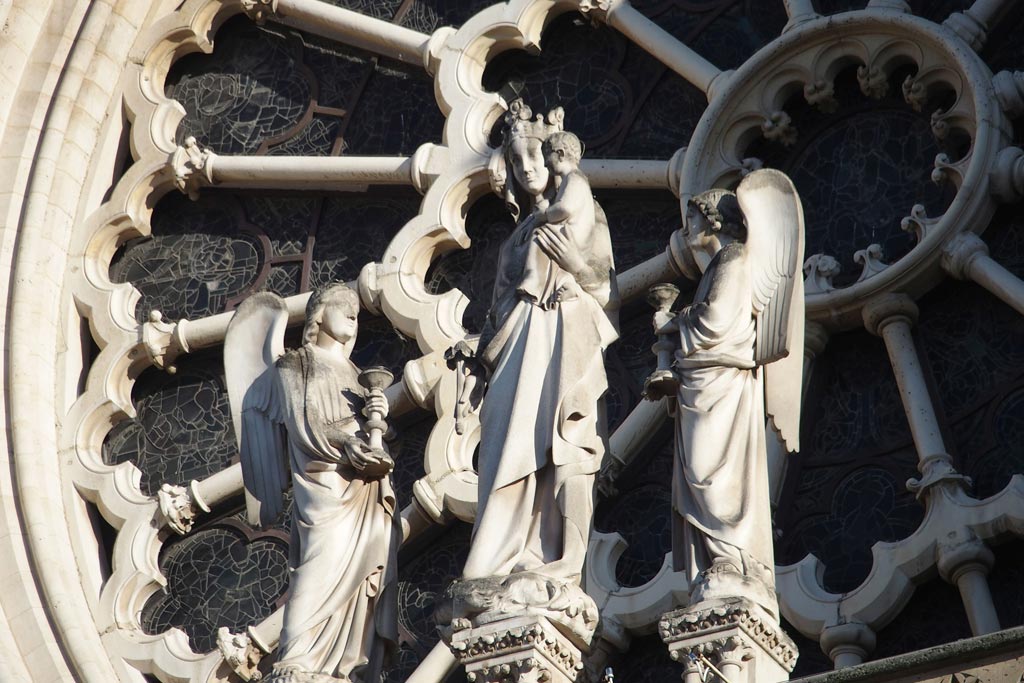
Maurice de Sully had the idea of building Notre Dame Cathedral shortly after he was named bishop of Paris. At that time, France was under the reign of King Louis VII.
Created to resemble the Cathedral of Saint-Denis, the first cathedral built in the Gothic style, the construction of Notre Dame of Paris began in 1163.
The construction took place in different stages. Between 1163 and 1182, the construction begins with the choir and the double ambulatory. Between 1182 and 1220, the last three bays of the nave, side aisles, and galleries. Between 1190 and 1225, the foundations of the façade and the first two bays of the nave, plus the connection of the two bays to the façade, which was raised to the Kings’ Gallery. Finally, from 1225 to 1250, the upper gallery, the two towers of the façade, and various alterations of the high windows and side chapels.
In 1270, the Cathedral was considered finished, but it underwent further modifications until 1345.
How to Visit Notre Dame Cathedral in 2025

Notre Dame is one of the most unique places in Paris to visit. After the inauguration, Notre Dame expects to receive 15 million visitors per year (it had 11 million visitors before the fire), which is 40,000 visitors per day! That’s about twice the number of visitors to the Château of Versailles, which has ten times the surface of the Cathedral to accommodate half as many visitors.
Although admission to Notre Dame will remain free, visitors can book a time slot online a few days before their visit. It will still be possible to enter without a reservation, but the wait will likely be long, very long.
You can read all the information to plan your visit and get the free tickets here.
Curious and Interesting Facts About Notre Dame Cathedral
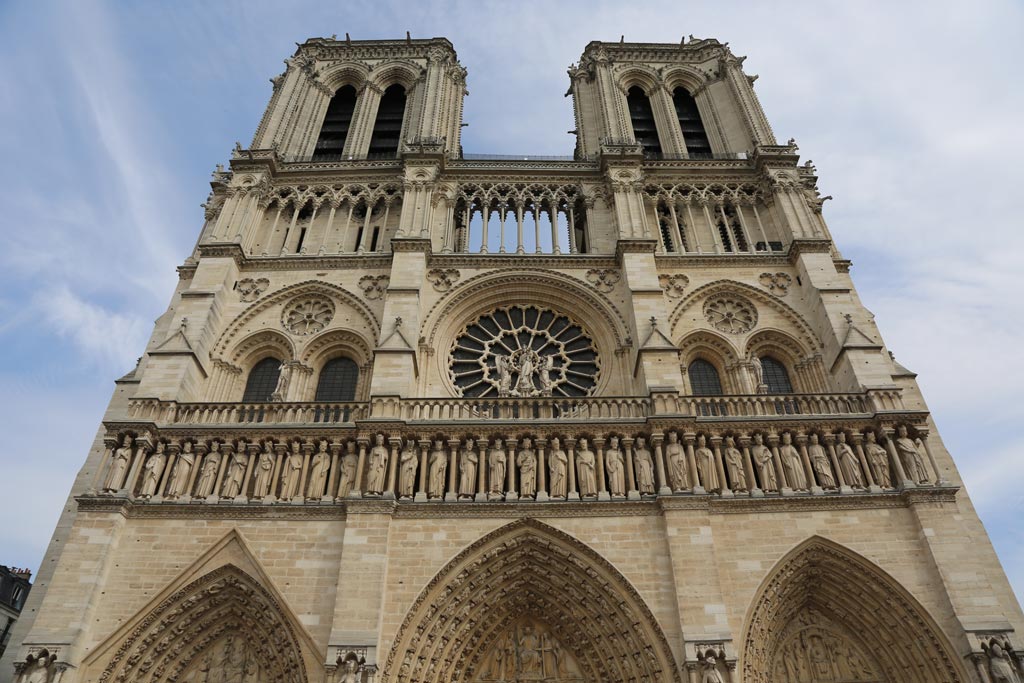
Notre Dame’s tall silhouette has watched over the Ile de la Cité and Paris for over 850 years. However, as a good witness to France’s history, this jewel of Gothic art has gone through many dark hours. From the Middle Ages to the twentieth century, here are some secrets and curious facts about Notre Dame Cathedral.
1. The Numbers of Notre Dame
Notre Dame Cathedral is a fantastic work of architecture, a real tour de force. The figures are impressive, especially considering it was built 850 years ago! Here are just a few numbers in bulk.
- 96 meters – the height of the spire; 69 meters – the height of the towers
- 13 meters – diameter of the rose windows north and south
- 1300 oaks, or 21 hectares of forest, made up the framework
- 500 tons of wood and 250 tons of lead in the spire
- 35 meters of vaults
- The organ is made of 8000 pipes
- The Cathedral can host 9 000 faithful
- 5 church services per day, 7 on Sundays, 2000 church services per year
- 32 000 visitors per day, 12 million visitors per year
2. Notre Dame was Built on the Grounds of four Churches
The site of Notre Dame is possessed by a strong magnetic tellurism. In Gallo-Roman times, the site was already occupied by a temple dedicated to Jupiter. Later, no less than four churches succeeded each other on the same site: an early Christian church from the fourth century dedicated to Saint-Etienne, a Merovingian basilica, a Carolingian cathedral, and a Romanesque cathedral.
3. The Origin of a Local Expression
The local expression “Je ne vais pas y passer 107 ans” (I’m not going to spend 107 years there) designates a long and arduous wait and would come from Notre Dame’s construction site, which started in 1163. It was not until the 1270s that most of the building was finished, and the district was no longer affected by the harm of the construction site.
4. The Square in Front of the Cathedral Hides Parts of the Roman City
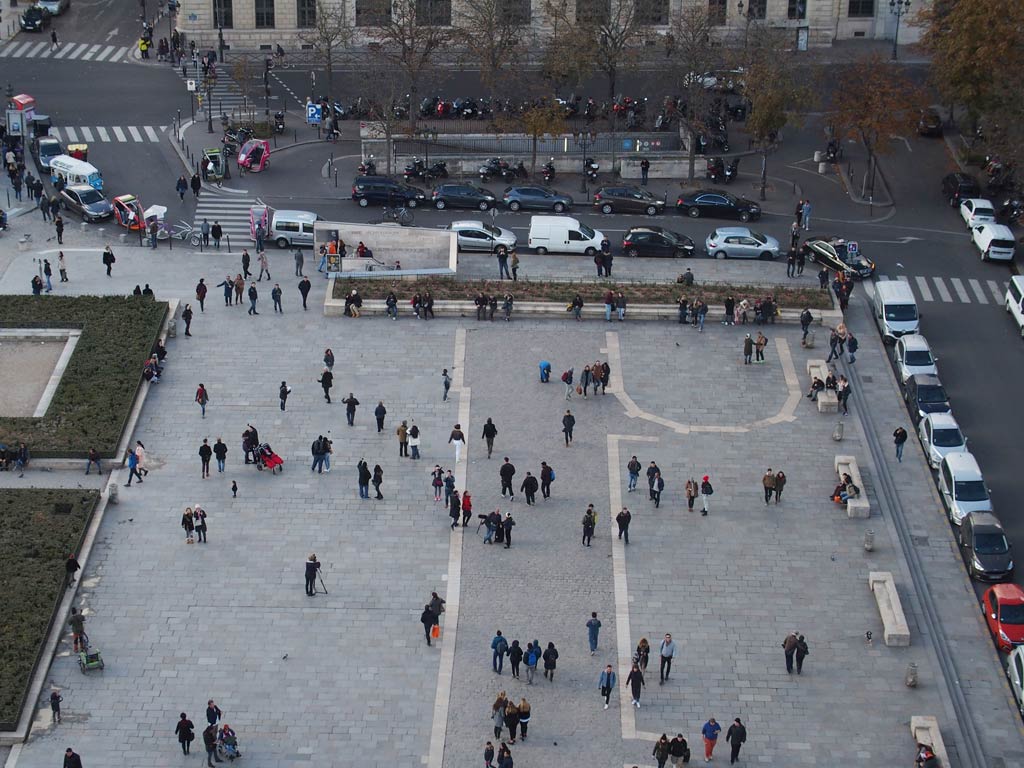
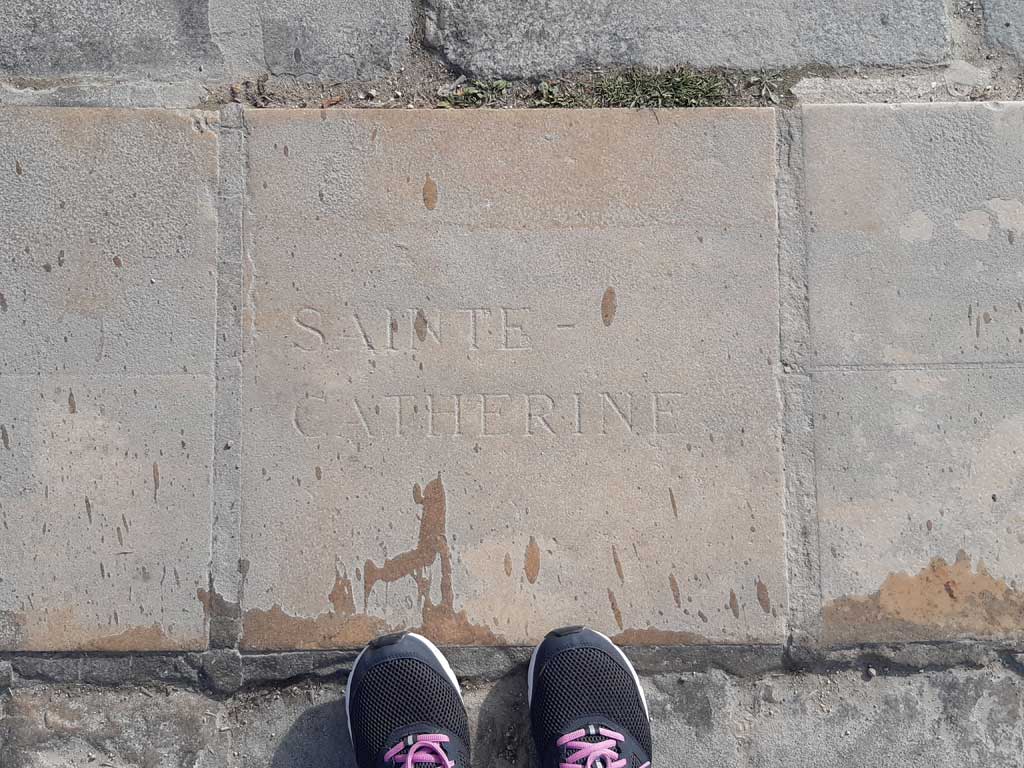
As for the square in front of the Cathedral, it was much smaller. You have to imagine houses and narrow streets in place of the current huge square. Still today, you can see the layout of some streets and small chapels where people could go to pray during the construction of the Cathedral. The picture on the left was taken from the towers before the fire.
Until the 50’s the square was used as an open-air parking. That’s right, you could drive and park your car in front of Notre Dame!
In the ’60s, during the excavations to build underground parking, Paris found parts of Lutèce, the Roman city! Head to the Crypte Archéologique to visit this part of the Roman city, with streets, public baths and a section of the quays of the Seine River in Roman times.
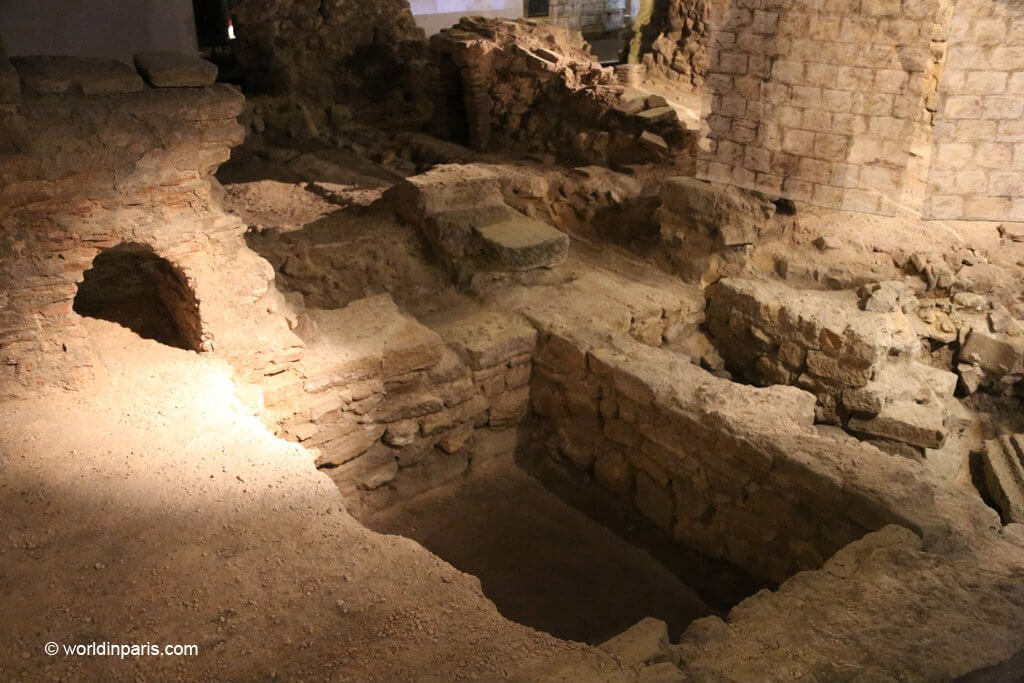
5. Notre Dame of Paris is NOT the Biggest Cathedral in France
Although it is the most famous Gothic building in France, Notre Dame de Paris is not the largest in terms of size; The cathedrals of Amiens and Beauvais are larger! Actually, it is said that one could fit three Notre Dame of Paris inside the Amiens Cathedral.
6. A Colorful Cathedral
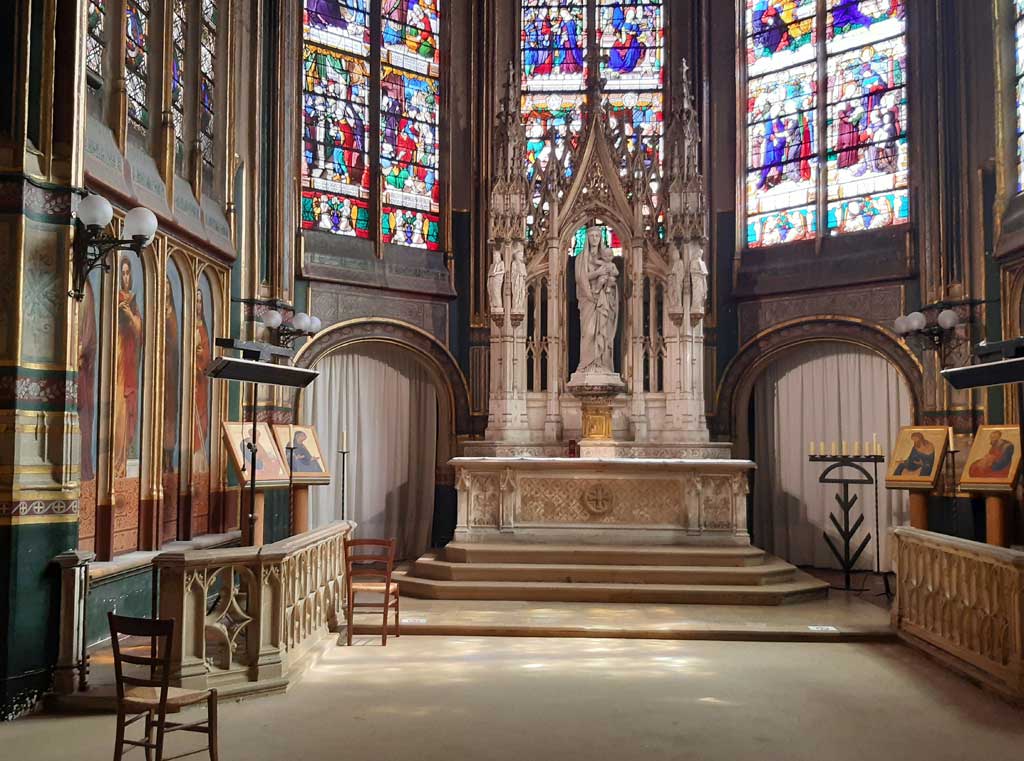
In the Middle Ages, the façade of Notre Dame of Paris was very different from the one we know today. Indeed, it was painted in bright colors!
If you want to know what Notre Dame looked like in Medieval times, visit the Chapel of the Virgin at the back of the Church of Saint-Gervais-Saint-Protais (13 Rue des Barres, also in the 4th Arrondissement.
7. Notre Dame’s Doors Forged by the Devil?

The doors of Notre Dame Cathedral are legendary for the quality of work and the finesse of the details. To this day, modern ironsmiths can’t figure out how the author managed to create such extraordinary and delicate work with the tools of his day.
According to legend, Biscornet, a young and talented ironworker, was commissioned by the Church to create the metal for the Cathedral’s doors for its inauguration in 1345. The work was gigantic and the deadline was approaching, so Biscornet started to stress.
Desperate, Biscornet contacted the devil to help him finish in time. The devil agreed to help him create the best and finest hinges to adorn the wooden doors in exchange for his soul.
In just a few days, Biscornet managed to complete these sublime locks. Nothing like this had ever been seen before! He was found unconscious in his workshop.
At the inauguration, the doors were impossible to open. The population began to whisper that the young ironworker had made a pact with the devil, which would also explain his absence from the ceremony. The bishop then ordered an exorcism ceremony: the hinges were sprinkled with holy water, and oh miracle, the doors opened! Biscornet is said to have passed away shortly afterward, but his masterpiece has fascinated the world for centuries.
8. Covered by a Beautiful Forest
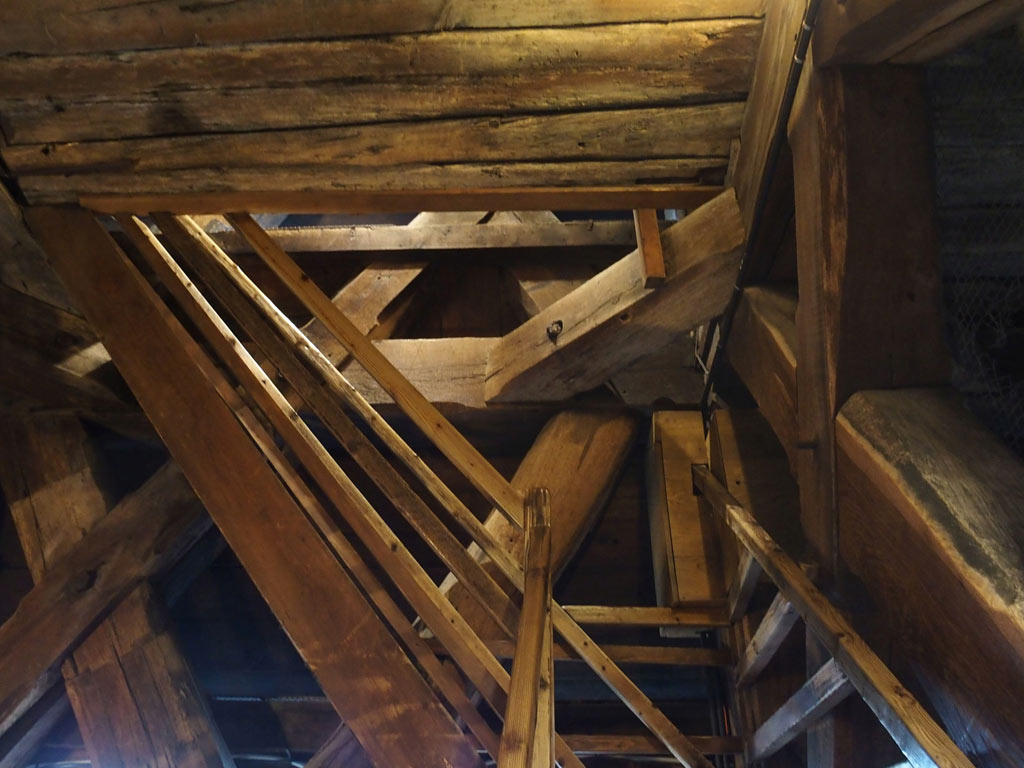
The frameworks of the choir and nave of Notre Dame Cathedral were among the oldest in Paris (late 12th – early 13th century). This roof was called “the Forest” because it represented the equivalent of 21 hectares of forest. Each beam came from a different tree in France.
9. The Largest Bell in the Cathedral is Called Emmanuel
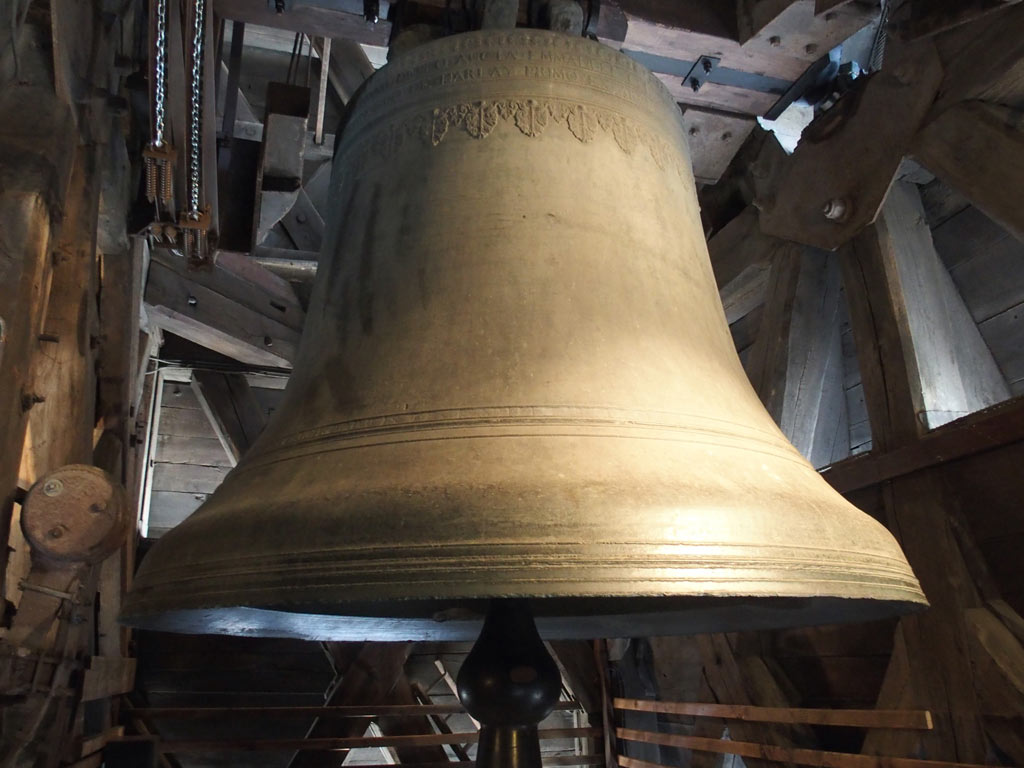
All the bells of Notre Dame of Paris have a name. But one of them is more important than the others: the Emmanuel bell. Built in 1683 and christened by his godfather, King Louis XIV, it weighs 13 tons! Emmanuel survived the French Revolution and rang to announce the Liberation of Paris in 1944.
10. Home to Important Relics
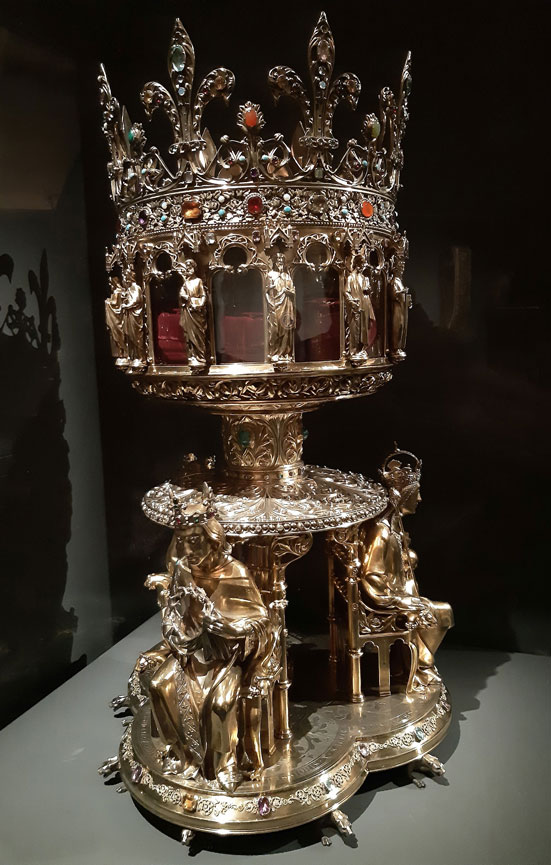
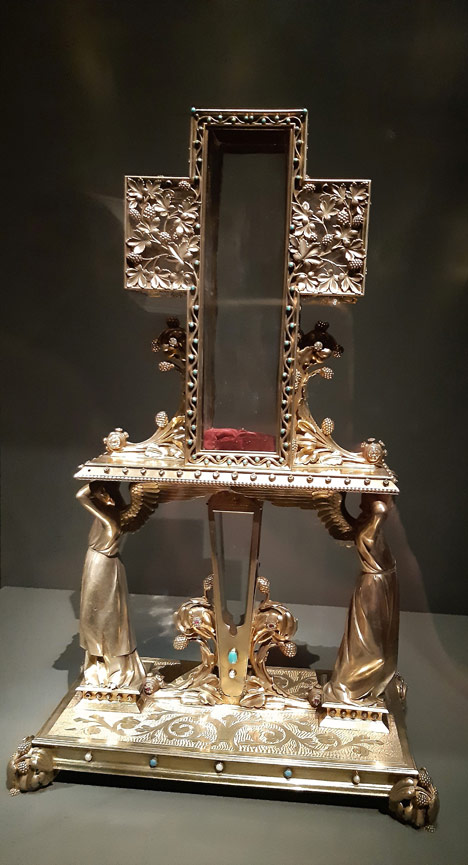
In the central part of the Cathedral, Notre Dame’s Treasure keeps relics of inestimable value. This incredible inventory, made up of numerous chalices, candlesticks, crucifixes, and richly ornamented Bibles, has as its centerpieces the Holy Relics: the Crown of Thorns, a piece of the True Cross, and a holy Nail. King Saint Louis’ tunic, his jaw, and one of his ribs complete the collection.
The return of the Crown of Thorns in Paris in 1239 cost King Louis IX half of France’s yearly budget! King Louis IX put France in debt for 50 years.
TIP: If you want to see the Crown of Thorns in Notre Dame Cathedral, there’s a bit of planning, as it is only displayed on certain days and time windows. Check out when to see the Crown of Thorns in Notre Dame.
11. Theater of a Curious Royal Wedding
In 1572, Notre Dame hosted a curious royal wedding: Marguerite de Valois and Henri of Navarre, the future King Henri IV. A Protestant, Henri was not allowed to attend the mass of his wedding and had to follow everything from the square in front of the Cathedral.
Other royal couples married in Notre Dame were Mary Stuart, Queen of Scotland, and François II, son of King Henri II (1558). Élisabeth de France and Felipe II of Spain (1559) — this was a proxy marriage where the Duke of Alba represented the Spanish King. Eugénie de Montijo and Emperor Napoléon III also married in Notre Dame (1853).
12. And a Place of Coronations
Although Reims Cathedral is the site of the coronation of the French kings, the Notre Dame Cathedral has also hosted two coronations.
In 1453, towards the end of the Hundred Years’ War, King Henry VI of England was crowned in Notre Dame. He did not reign in France because Charles VII had already been crowned King of France in 1429 in Reims.
In 1804, Napoléon Bonaparte was crowned Emperor by Pope Pius VII. The ceremony was represented by the painting “The Coronation of Napoleon” by Louis David. Today, you can see this incredible painting at the Musée du Louvre.
13. Notre Dame Became the Temple of Reason
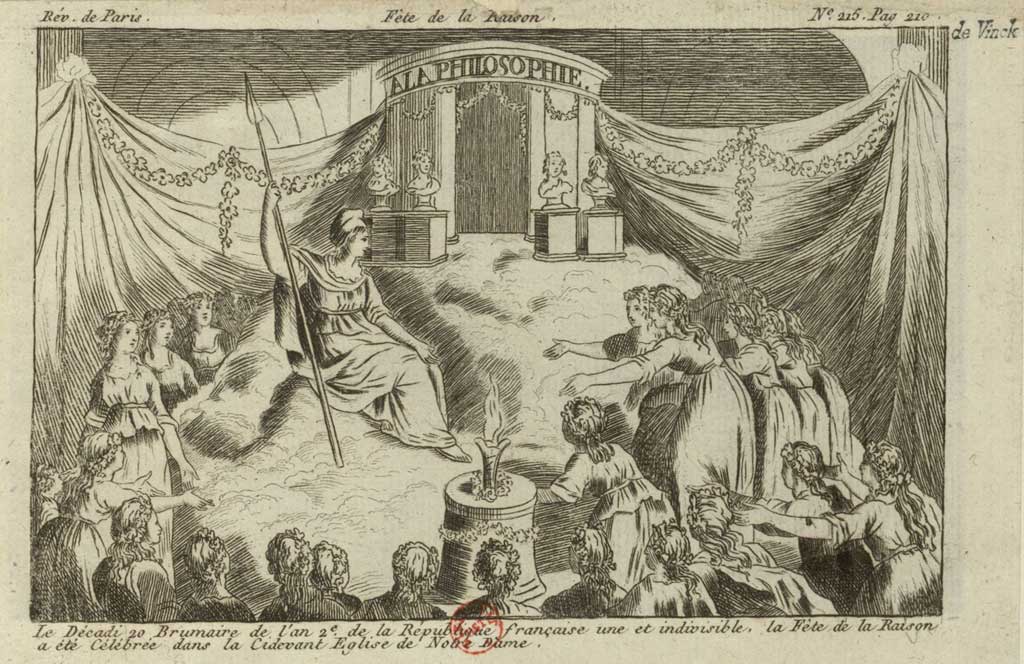
In 1793, during the French Revolution, the Paris Commune transformed Notre Dame into a Temple of Reason to practice the cult of the Supreme Being. Badly damaged, the Cathedral was also used as a warehouse.
The image above represents the Fête de la Raison inside Notre Dame Cathedral (year 2 of the French Republic). The main altar was covered by a mountain of sand.
14. Notre Dame’s Beheaded Kings
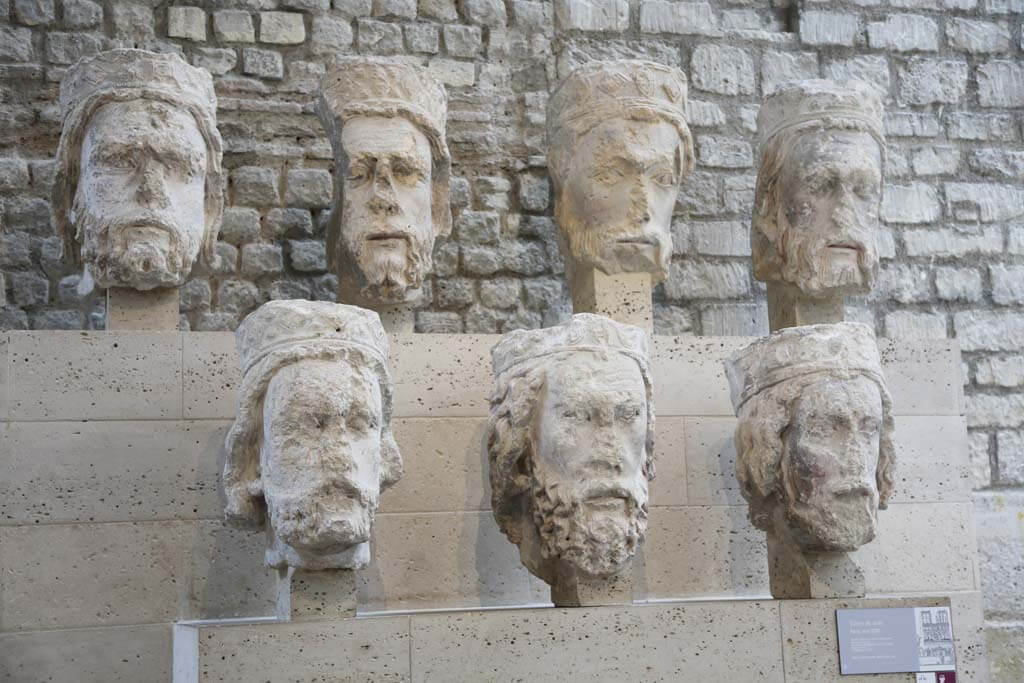
Above the portals is the Gallery of Kings, an ensemble of 28 statues representing the kings of Judah, ancestors of Mary. During the French Revolution, these statues were beheaded by the revolutionaries who saw kings of France in them.
During the restoration of the 19th century, the heads of the kings were replaced. Curiously, the eighth king counting from the left now looks like Viollet-le-Duc!
Years later, the original heads were found in a Parisian mansion and are displayed today at the Musée de Cluny.
15. Victor Hugo “Saved” the Cathedral
Did you know that Notre Dame almost disappeared in the 19th century? Devastated by the French Revolution, the Cathedral was so dilapidated that there was talk of demolishing it. This was without counting on Victor Hugo, who, with his great novel “Notre Dame de Paris” (1831), aroused the locals’ interest in the Cathedral.
“All Paris was spread out at his feet, with her thousand turrets, her undulating horizon, her river winding under the bridges, her stream of people flowing in the streets; with the cloud of smoke rising from her many chimneys, with her chain of crested roofs pressing in ever-tightening coils round about Notre Dame” Victor Hugo – Notre Dame de Paris, Chapter 2
The writer was heard: in 1845, a vast restoration program was entrusted to the architect Eugène Viollet-le-Duc.
16. An Intruder Among the Apostles
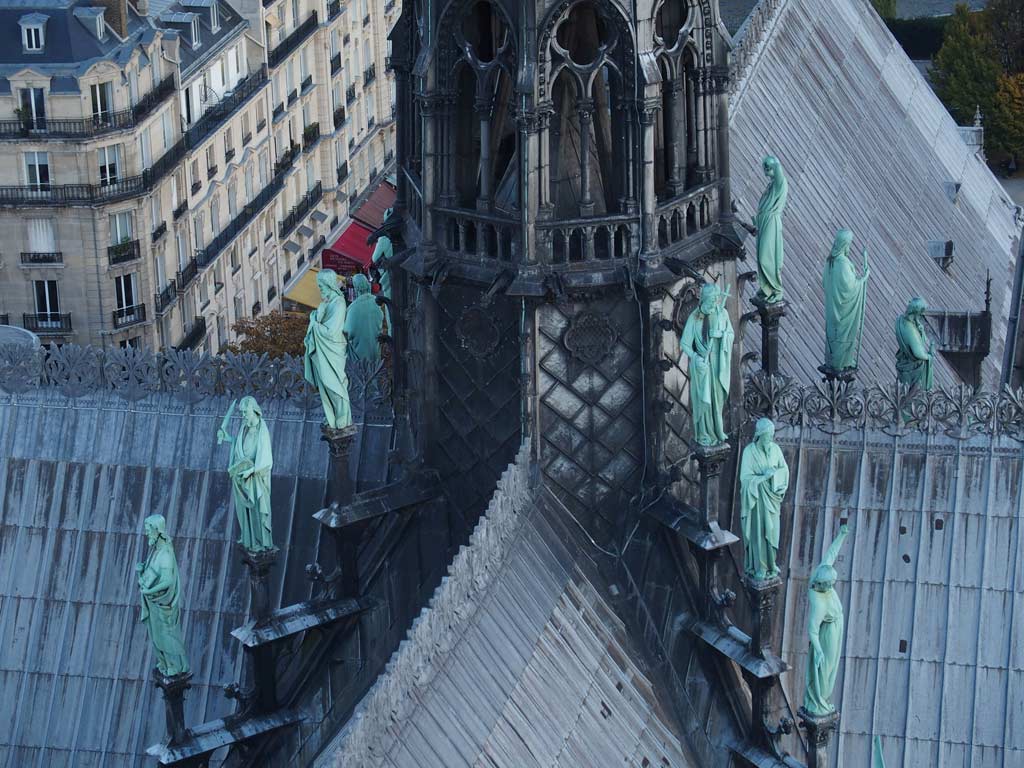
The Cathedral’s central spire, which collapsed during the 2019 fire, was added by Viollet-le-Duc.
The statues of the 12 apostles surrounding the spire were all made during the Cathedral’s restoration by Viollet-Le-Duc in the style of the 12th century. Viollet-le-Duc signed his work in a very original way, depicting himself as Saint Thomas contemplating his work! For the record, Saint Thomas is the patron saint of architects.
The statues were retired to be restored only a few days before the fire; they were very lucky!
17. Notre Dame’s Chimeras vs. Gargoyles
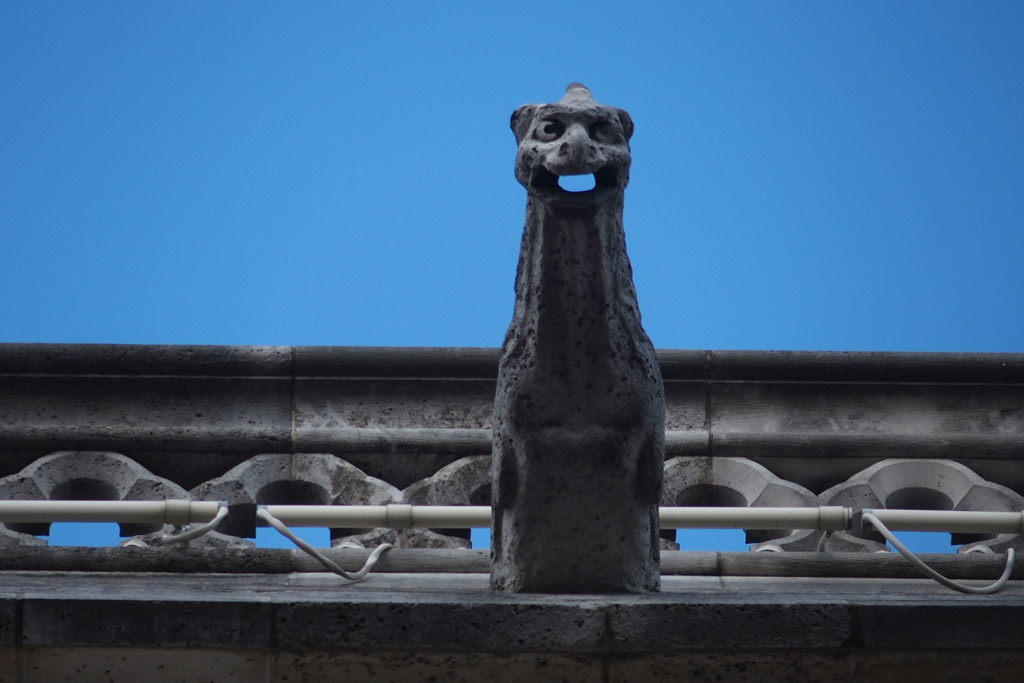
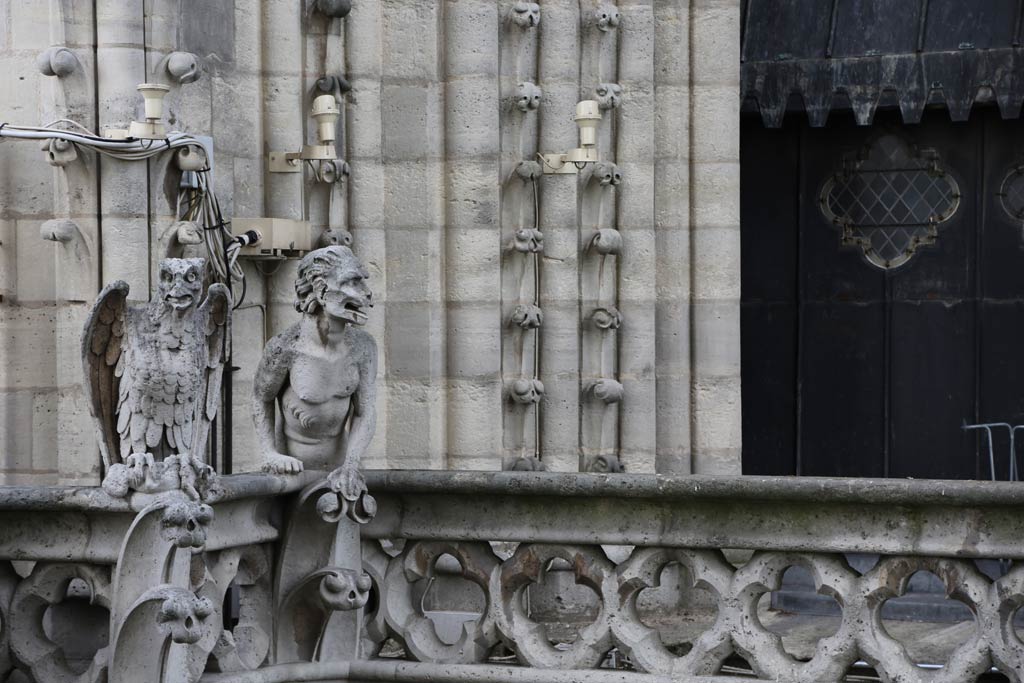
Often confused, there’s a difference of 500 years between Notre Dame’s gargoyles and chimeras!
Gargoyles are the Cathedral’s ends of gutters intended to drain off rainwater and they were built in Medieval times. Crafted as demons and fantastic creatures, they were intended to repel evil spirits who would try to enter the house of God.
Notre Dame’s chimeras didn’t exist in Medieval times. They are a pure creation of the architect Viollet-le-Duc to decorate the balconies of the gallery.
18. Point Zéro
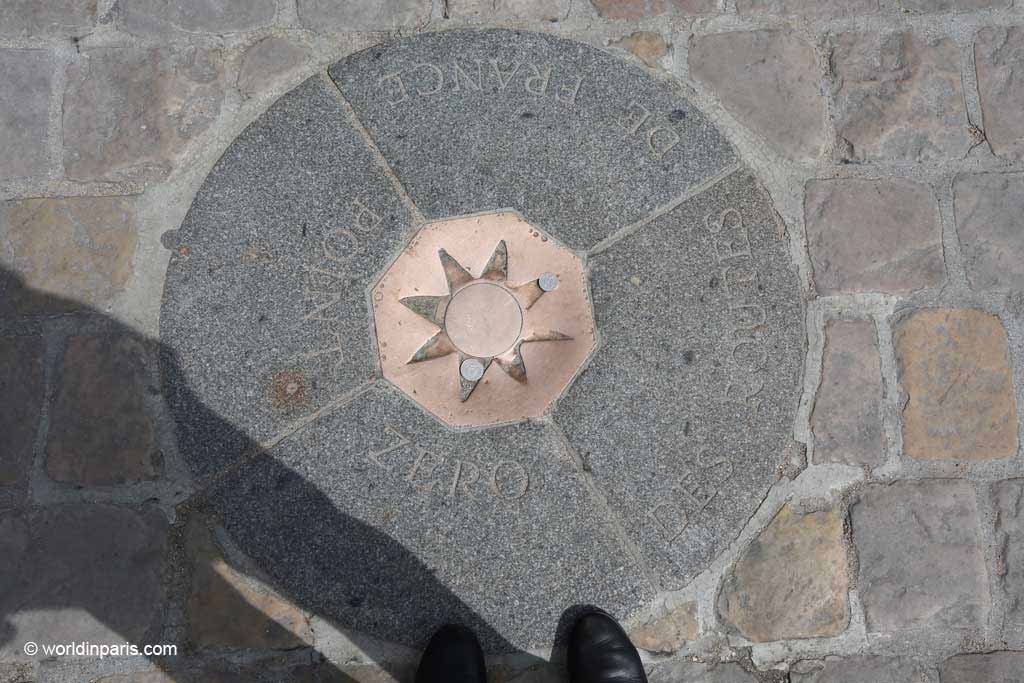
In the center of the square in front of the Cathedral, there is a concentric plate on which is written “Point Zéro.” This plate is considered the place from which all distances in France are calculated. If you step on it, you are in the exact center of the city of Paris!
19. Rebuilt in the Gothic Style
After the fire in April 2019, the French President Macron acknowledged the disaster:
“Notre Dame is our history, our literature, part of our psyche, the place of all our great events, our epidemics, our wars, our liberations, the epicenter of our lives … So I solemnly say tonight: we will rebuild it together.”
A day after Macron’s speech, 880 million euros were pledged to fund the restoration of the Cathedral. Despite many architects submitting various designs, including one with a swimming pool, the French government decided to restore the original Medieval style.
20. The Compagnons du Devoir on the Front Line for the Reconstruction of Notre Dame
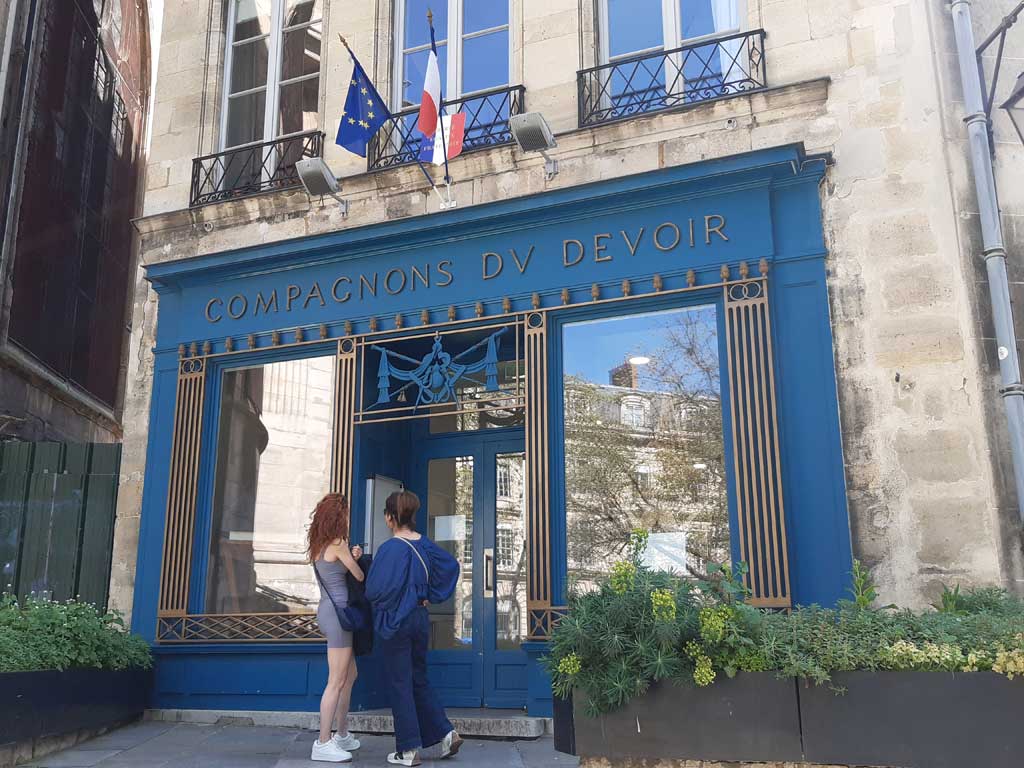
The Compagnons du Devoir (Companions of Duty in English) is a secretive brotherhood of craftsmen set up in the Middle Ages. Based in France, the Compagnons du Devoir are among the world’s best craftspeople. For more than 900 years, the Compagnons’ training centers have been transmitting French know-how in all craft trades through work-study training that begins in the third grade.
Trained over the years in a long process with rituals, secretive practices, and devotion to their trades, their initiations are held behind closed doors, and inevitably, a connection with freemasonry springs to mind.
The Compagnons du Devoir have been key for the reconstruction of Notre Dame. They have been using Medieval techniques with modern tools.
21. A Spiritual Lightning Rod
An emblematic piece of the Cathedral, the golden rooster, sits again on the top of the spire of Notre Dame. It is a new golden rooster designed by Philippe Villeneuve, the chief architect of French historical monuments. The previous one, believed to have been consumed by the fire, was found the day after, but it was too damaged to be restored.
In Christianity, the rooster symbolizes the return of light after nightfall. The rooster is also one of the emblems of France.
Notre Dame’s rooster is also considered a spiritual lightning rod, as it contained a piece of the Saint Cross, a piece of Saint-Denis, and a piece of Sainte-Geneviève. In addition to the relics, spared from the fire, the new golden rooster contains a sealed tube with the names of nearly 2000 people involved in the reconstruction of the Cathedral.
Pin it Now and Read it Later!


